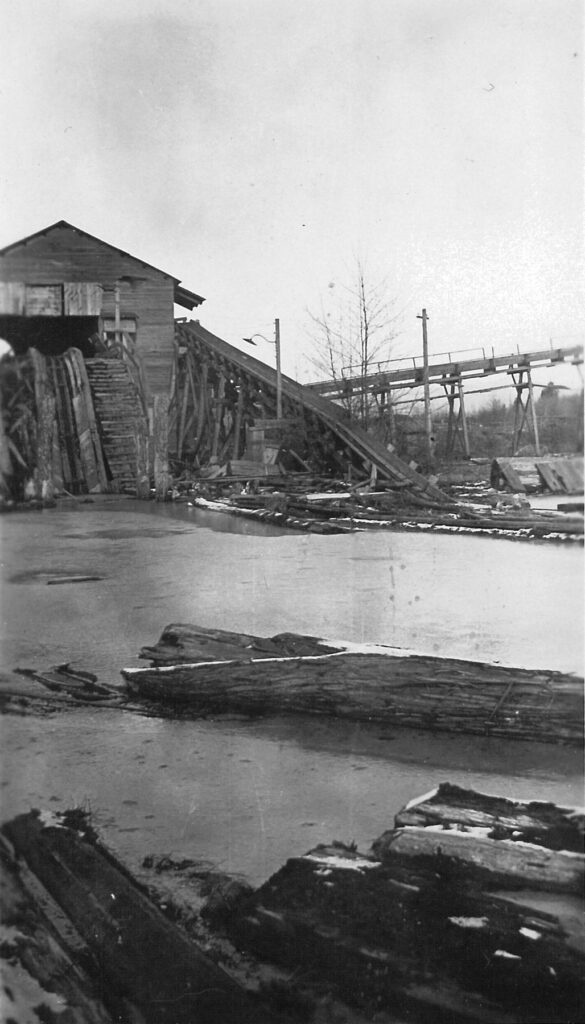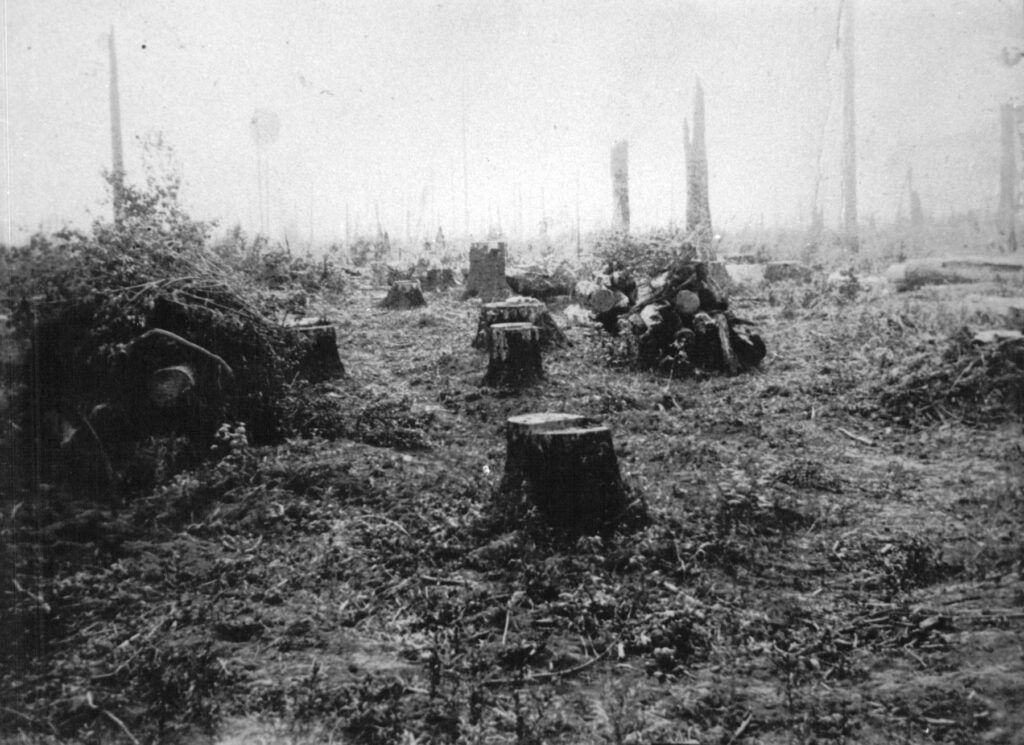What was the Depression?
The 1920s had been a high point in the economy of British Columbia and Canada with most residents feeling the effects. This changed on October 29, 1929, “Black Tuesday”, when international markets crashed, bringing down the economy within Canada as well. Production and exports within British Columbia fell by 60% and unemployment reached 31% by 1931. Between 1931 and 1934 British Columbian Premiers attempted to alleviate these issues by gradually introducing work camps, increasing public work projects, introducing health insurance, increasing to a 48-hour workweek, and raising both the male and female minimum wages.[1] These efforts may have helped but they were not able to stop the effects of the depression that raged across the world.

Effects on the Abbotsford Economy
The two main economic producers in Abbotsford were the lumber industry and the farming industry. The majority of immigrants in Abbotsford, of all backgrounds, were engaged in one of these fields. Both would be inhibited by the Great Depression.
Lumber production was severely crippled as the main purchaser of Canadian lumber, the United States, was also hit hard by the recession. Canadian production of lumber fell from 10 million cubic metres of lumber in 1928 to 5 million cubic metres of lumber by the early 1930s.[2] This meant that there would be fewer jobs in the lumber industry. Considering that the Trethewey’s Abbotsford Timber & Trading Company was the largest employer in Abbotsford this had a significant impact on the local economy.[3]

The second economic contributor in Abbotsford, farming, also suffered significantly in the depression. Drought occurred in Canada and many parts of the world making farming more difficult.[4] Even though this was not significantly problematic in Abbotsford it led to a drastic increase in migration from other parts of the country and British Columbia or at least fed into increased fears of immigration. Within British Columbia migration at this point often went from the cities to the farming regions like Abbotsford as the cities faced higher unemployment more quickly and people often returned to their family homes in search of work.[5] Another group that migrated to Abbotsford with the aim of farming during the depression was Mennonites. The increase in farmers and the decrease in the quality of some farmland led to rising complaints from some groups. Particularly the group deemed the soldier settlers, veterans from the First World War who had been granted special agricultural loans. This group of Abbotsford residents raised significant demands on the government to have their loans forgiven as they felt that their loans would be impossible to pay back as the land could not produce enough to both feed a family and create revenue.[6] Further, they said that these demands were causing insanity and suicide for the soldier settlers.

What did this mean for employment?
In Abbotsford, these issues were felt especially strongly as most of the employment in the town came from the logging industry, which as discussed above faced many significant effects from the Depression. This led to mass layoffs at the Abbotsford mill in July 1930, which while likely necessary, harmfully and unnecessarily targeted the Japanese and South Asian populations to maintain European jobs.[7] The racism of this decision led to a wide disparity in the way that the depression affected different populations within the region. To explore this more visit the pages devoted to the Japanese and South Asian Abbotsford populations.
Soon after the layoffs at the Abbotsford Lumber Mill, there is evidence that the unemployment rates only continued to climb. One example of this is found on November 5, 1930, when an article from the Abbotsford Sumas Matsqui News mentioned that there were 106 applications for relief work from Matsqui alone.[8] This number may appear small, but it contrasts with the 40 applications that the city had expected to receive. Considering that the relief work was often not ideal and could be heavily stigmatized it is significant that the city received nearly triple the expected applications.
Effects on the Abbotsford Community
The Great Depression was triggered by the stock market crash of October 1929. Considering this one of the major effects was the loss of faith in this institution as a safe source of investment. This is frequently commented on by the Abbotsford Sumas Matsqui News. For example, the Vancouver Stock exchange began to purchase ads frequently in an attempt to convince the public of the benefits of investing in the stock market.[9] However, it is clear that this was not enough to convince the public as other articles such as, “Has the Public Lost Confidence?” complained about the practice and highlighted the expense they have taken for these ads.[10] The decrease in faith in the practice of stock investment was only one of the minor effects the depression had on the Abbotsford community.

One of the most significant effects of the depression was an increase in the fears around immigration and minorities taking jobs. Many would blame the unemployment being faced by the European colonists on continued immigration – particularly Japanese which you can read more about here. The blame was focused on migration into British Columbia and Abbotsford by men, of all heritages, searching for work.[11]
Click here for a bibliography for this page. Click here for a full website bibliography.
[1] “Discover Your Legislature.” 1929 to 1939 – Great Depression Alters B.C.’s Economy. Legislative Assembly of British Columbia, n.d.
[2] Couture, Lydia, and Ryan Macdonald. “The Great U.S. Recession and Canadian Forest Products”, (Economic Insights, No. 28. Statistics Canada, Economic Analysis Division, 2013), 1.
[3] Trethewey, Clarke. “Interview Notes from Conversation with Clarke Trethewey”, Immigration & Settlement Japan Immigration Profile 2006. The Reach Gallery Museum, Abbotsford.
[4] Anonymous. “Notes”, Mennonite Project. The Reach Gallery Museum, Abbotsford.
[5] KODAK Capture software. Memorandum on Employment: Employment at Dec. 1, 1933 Compared with That at the Low Point, at Dec. 1, 1932, and at the High Point of the Present Cycle. : Documents Collection. Dominion Bureau of Statistics, 2013.
[6] Heller, Gerald H., ed. “Shylock Methods Used by Land Settlement Board War Veterans Assert at Largely Attended Meeting.” Abbotsford, Sumas, Matsqui News. February 19, 1930.
[7] Heller, Gerald H., ed. “Orientals Fired at Lumber Mill.” Abbotsford, Sumas, Matsqui News. July 9, 1930.
[8] Heller, Gerald H., ed. “Matsqui Gets 106 Applications for Relief Employment.” Abbotsford, Sumas, Matsqui News. November 5, 1930.
[9] Heller, Gerald H., ed. “Vancouver Stock Exchange.” Abbotsford, Sumas, Matsqui News. January 8, 1930. and Heller, Gerald H., ed. “Stock Exchange Useful Institution.” Abbotsford, Sumas, Matsqui News. January 22, 1930. show this phenomenon along with many other editions of the paper as there was a weekly ad taken out to advertise investments.
[10] Heller, Gerald H., ed. “Has the Public Lost Confidence.” Abbotsford, Sumas, Matsqui News. January 29, 1930.
[11] Heller, Gerald H., ed. “Immigration and Unemployment.” Abbotsford, Sumas, Matsqui News. January 29, 1930.